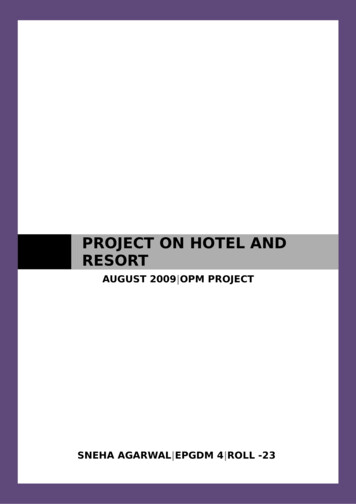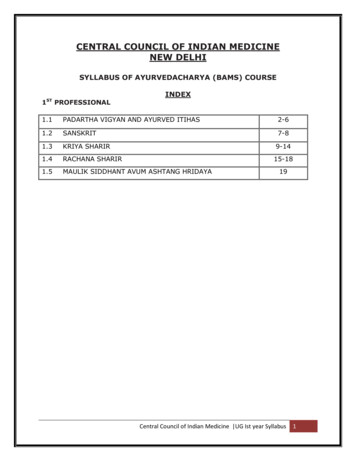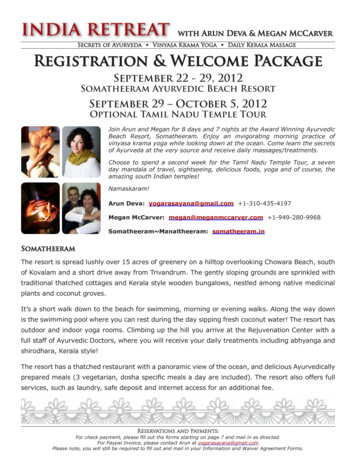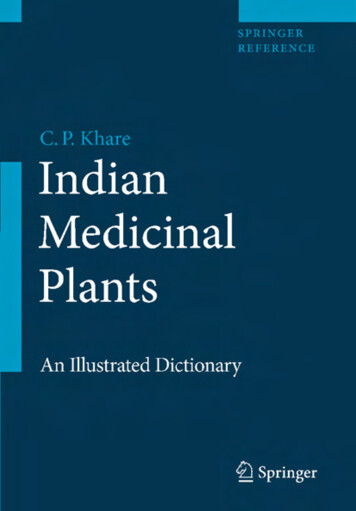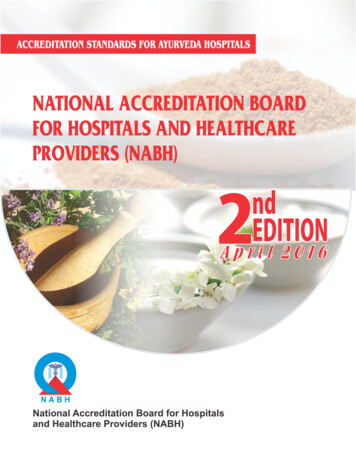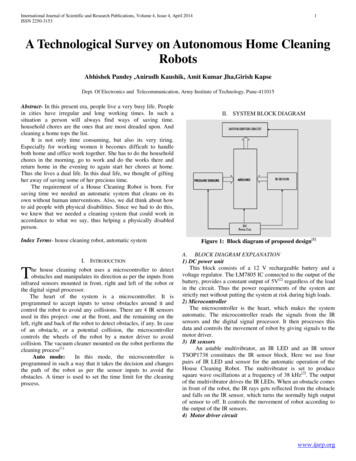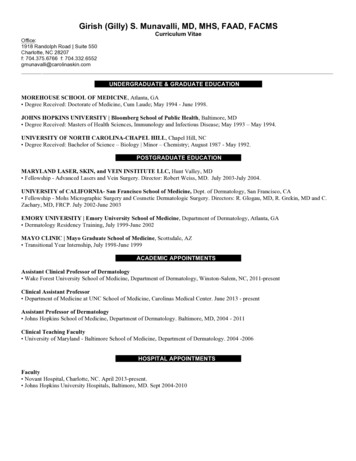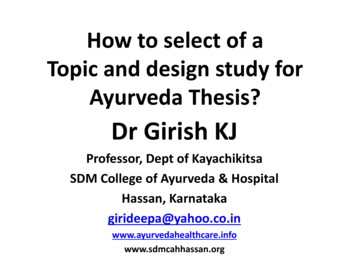
Transcription
How to select of aTopic and design study forAyurveda Thesis?Dr Girish KJProfessor, Dept of KayachikitsaSDM College of Ayurveda & HospitalHassan, re.infowww.sdmcahhassan.org
Scientific inquiry is seeing whateveryone else is seeing, but thinkingof what no one else has thought.A. Szentgyorgyi, 1873 (he won the Nobel Prize for isolatingVitamin C)
Topics covered Introduction Need for Study / Research & Selection ofproblem Writing hypothesis / research Objective Review of Literature including literaturesearch Points to be considered about ResearchDesign Considerations about Interventions
Introduction The growing popularity of Ayurveda aroundthe globe created new challenges to theAyurvedic fraternity. Although Ayurveda is Practical and Clinicaloriented, there is need of systematizedscientific research, for this both philosophyand science are equally important as quotedby Einstein “philosophy without science isblind and science without philosophy islame”. With sound scientific evidence, modern worldwill accept the Ayurveda.
A thesis (Often Bachelors/Masters)or dissertation (often Doctoral) is adocument submitted in support ofcandidatureforanprofessionalqualification (MD / MS (Ayurveda)presenting the author's research andfindings.(International Standard ISO 7144: Documentation—Presentation of theses andsimilar documents, International Organization for Standardization, Geneva, 1986.)Research during postgraduation is as PartialFulfillment of PG Curriculum
Synopsis or Protocol A document that states the background,objectives, rationale, design, methodology(including the methods for dealing with AEs,withdrawalsetc.)andstatisticalconsiderations of the study.
Why Research needed inAyurveda? To validate the principles & practices told in theclassics in specific disease or condition/stage ofdisease To develop safe, effective & economical new drug orformulation To find the new actions of the drug or formulation To find out new nidana & their role in samprapti To develop new analytical tools for QC To study the actions of currently used dietetics
General Considerations Evaluate Ayurveda in its own theoreticalframework Evaluate Ayurveda in the theoreticalframework of Conventional Medicine Compare the efficacy of AyurvedaMedicine and/or Conventional Medicine; Compare the efficacy of differenttraditional medicinal systems
Methods of Research inAyurvedaChaturvidha Pareeksha Literary review – Aptopadesha Hypothesis- Anumana Selection of patients – Aptopadesha, Pratyaksha Interventions- Yukti AssessmentAptopadesha,Pratyaksha,Anumana
Methods of Research in AyurvedaPancha Avayava Pratijna- Defining Problem/Hypothesis /Objective Sthapana- ve hypothesis Pratishthapana- null hypothesis Hetu – Reasoning (Need for the study) - Pratijnashould be Sahetuka (why you have taken research?) Udaharana- (experimental) - Observations & results Upanayana- Uhapoha- (Discussion &interpretation) Nigamana- Conclusion (recalling the Pratijna,whether the Pratijna proved or disapproved)
Steps involved in AyurvedaResearch Selection of Areas of Research /defining problem /formulating researchable question / formulation ofhypothesis Review of Literature Formulating Hypothesis and Research Objective Planning of Research (Research Design) Submitting it as a research proposal for Ethics Committee& University / Funding agency approval Implementation of the research project Data Collection, Data Analysis & Interpretation Publishing the research findings
Good Research Problem
Criteria – Good Research Problem“FINER “ F Feasible I Interesting N Novel E Ethical R RelevantWhile considering P PopulationI InterventionC ControlO Outcome
Feasible Sufficient resources in terms of time,staff, and funding Use of appropriate study design Manageable in scope Adequate sample size Trained research staff
Interesting Interesting as a researcher or guide Investigator’s motivation to make itInteresting
Novel Confirms, refutes or extendsprevious findings Provides new findings Thorough literature search Newfindings or extension of previous findings Guidance from mentors and experts
Ethical Following ethical-guidelines Regulatory approval fromInstitutional Review BoardIEC/
Relevant To scientific knowledgeTo clinical and health policyTo future researchInfluence on clinical practice / AyurvedaFurthering research and health policy
Selection ofResearch problem(Areas of Research)
Steps in identifying aresearch problem in Ayurveda Step 1 : Determining the field of research inwhich a researcher is keen to do the researchwork. Step 2 : The researcher should develop themastery on the area or it should be the field ofhis specialization. Step 3 : He should review the researchesconducted in area to know the recent trendand studies in the area.
Steps in identifying aresearch problem Step 4: On the basis of review, researcher shouldconsider the priority field of the study. Step 5: Reseacher should draw an analogy andinsight in identifying a problem or employpersonal experience of the field in locating theproblem / gap in the current knowledge. maytake help of guide or expert of the field. Step 6 : Researcher should pin-point specificaspect of the problem which is to be investigated.
Ayurveda Postgraduation MD (Ayurveda) MS (Ayurveda)Ayurveda Samhita and Siddhanta Shalya TantraRachana Sharira Prasuti tantra & StrirogaDravyaguna VigyanaRasashastra & Bhaishajya kalpanaKaumarabhrityaSwasthavritta & YogaKayachikitsaMano Vigyan Avum Manasa RogaRoganidan Avum Vikriti VigyanPanchakarmaAgada Tantra Avum Vidhi Vigyan
Practical StepsIn Clinical specialties / Applied Study Choose one / two Srotas which really evokesinterest in you and guide also has agreementand expertise on that. Survey the OPD / IPD register and aboutavailability of Patients / subjects Brainstorm among your classmates abouttheir choice of thesis topic / disease. Discuss with your guide about your choice ofarea and come to a common point
Practical StepsIn Clinical specialties / Applied Study You have to answer certain questions?– Why you have chosen particular disease? Specificdisease condition / Roga / Doshavastha?– Why you have chosen specific treatment / procedure/ regimen? (Justification with relevant scientificbackground is very important)– If you are comparing, you have to give reason.advantage of new treatment / procedure / over oral /other treatment needs to be clearly mentioned?– Source or reference about specific action or use /indication is very essential
Practical StepsIn Clinical specialties / Applied Study Most important point about selection ofproblem– Problem should be relevant to your speciality– You need to “just” specifically state the problemrather than explaining problem– If you can define the Problem properly, yourresearch has real meaning
Areas of ResearchMD (Ayurveda) - Kaumarabhritya Pranavaha – Kasa, Pratishyaya (Recurrent URTI),Tamaka Shwasa (childhood asthma), Tundikeri(tonsillitis) Annavaha – Grahani Dosha, Krimi (Kosthagata) Raktavaha–Pandu(IDA)Thalassemia(Beejadushtijanya Pandu), Mootravaha – Shyyamutra Sarvadhatu – Karshya in children Mamsa, Majjavaha - Vatavaha – cerebral palsy Manovaha – ADHD, on IQ of school going childrenmental retardation
Areas of ResearchMS (Ayurveda) – Shalya Tantra Surgically managed condition : ? Conditions Managed with parasurgical measures(Kshara/Kshara Sutra): Arsha / Arsha (withKasisadi Taila)/ Bhagandara (Fistula-in-ano) /Parikartika (chronic fissure-in-ano) (with KsharaSutra) Conditions Managed with parasurgical measures(Agni): Gridharsi / Katishoola / Sandhigata Vata(Cervical spondylosis/OA of Knee joint) Conditions Managed with parasurgical measures(Jalaukavacharana): thrombosed piles
Areas of ResearchMS (Ayurveda) – Shalya Tantra Conditions Managed with local measures :Dushta Vrana (Diabetic ulcer) Conditions Managed with oral medications:Arbuda Gala Laryngopharyngeal Carcinoma,Asthi-bhagna / Closed Upper Limb Fractures /Mootraashmari (Paniya Kshara) / Mootraghata(BPH) / Simple fracture Pre-Anaesthetic Effect of certain drugs:
Areas of ResearchMS (Ayurveda) – Prasuti Tantra & Stree Roga Prasuti Tantra Pregnancy –– 1st trimester – Garbhini Cchardi– 2nd trimester – Kikkisa– 3rd trimester – Kikkisa– On Prasava – Basti Karma, oral medicines Garbhini related complications - GarbhiniMutrakricchra, Putraghni Yoni Vyapad (habitualabortion), Garbhini Pandu, gestational hypertension
Areas of ResearchMS (Ayurveda) – Prasuti Tantra & Stree Roga Stree Roga– Infertility (Vandhyattva) : ovarian factor(anovulation) / tubal factor (tubal blockage) /cervical factor / endometrial factor– Menstrual diseases: Kasthartava (Dysmenorrhoea)/ Artava-Kshaya / Asrigdara / Alpartava /Shwetapradara– Menopausal syndrome / PostmenopausalOsteoporosis– Diseases : Arbuda (uterine fibroid), GarbhashayaGreevamukhagata Vrana (cervical erosion)
Approach towards preparing synopsisin Basic Principles Can be Literary or Applied research Choose Basic Principle / Nyaya / Vada Choose Basic Principle and do applied study (mayin human / animal / in vitro model) Choose a chapter and study in depth Choose Manuscript and editing Vast opportunity to standardize basic concepts ofAyurveda Requires lot of involvement
Approach towards preparing synopsisin Rachana Sharir Choose a basic Rachana Sharir concept –do cadaveric study Pramana Sharir Marma Sharir
Areas of ResearchMD (Ayurveda) - Dravyaguna Rasa – Effect of Rasa Atiyoga on various systems pharmacological (animal) studies Activity- Anti-Hyperlipi daemic (ex. Vacha), Antipyreticand Analgesic Activities (ex. Chirabilva), Antispasmodicand Muscle Relaxation Activity (ex. Patha)hepatoprotective (Ex. Dronapushi) –pharmacological(animal) studies Karma – Deepana (Vidanga), Kasahara (Kanthakari),Mootrala (Kusha), Shvasahara (Tamraparna), Vishaghna,Vrishya (Putranjeevaka) - pharmacological (animal)studies with applied clinical studies
Areas of ResearchMD (Ayurveda) - Dravyaguna Disease specific indication (Ex. : Amavata, Amlapitta,EHT, Grahani, Kushtha, Vicharchika, ogical (animal) studies with applied clinicalstudies Identification of various sources of plants includingadulterant – pharmacognostico-phytochemical studies Study on Paryaya drugs - pharmacognosticophytochemical studies Compare the parts of various species of plant aboutclaimed effect (Ex. Bala moola, seeds of Dadima) pharmacognostico-phytochemical studies
Approach towards preparing synopsisin RSBK All basic Bhaishajya Kalpana - variations Standardization of thousands offormulations Variation in preparation methods andtheir effect on clinical outcome Shelf life study . .
Approach towards preparing synopsisin Roga Nidana Diagnostic standards of all the Ayurvedicdiseases Pariksha . Upashayatmaka study Mostly requires survey study with largersample size Ample scope for development of scalesfor assessment
Approach towards preparing synopsisin Agada Tantra Role agada in diseases – Vicharchika(Agada Prayoga) May be in human or animal model Vishavaidya Practices – Field survey
Review of Literature
Review of Literature You have to review the relevant literature /concepts from classics, previous thesis,Ayurveda journals and latest research updatesfrom databases. First of all, define the basics i.e. disease/conditions/concept clearly “with relevantreferences”.
In Review of Literature you should Collect all the relevant materials (withreference) Compile the literature keeping in mindabout the research problem andhypothesis in mind Synthesis the concept so as to reflect asall aspect / facets of research problemand topic
Offline &Online ResourcesSamhita, E-Samhita, e-resourcesOld ThesisMedical Search Engines: Pubmed, Googlescholar, RGUHS-Helinet, Medknow Journals,MedIndJournal Websites – Ayurveda and BiomedicineGeneral Websites about MedicineGeneral Websites related to Ayurveda
Searching E-Samhitasfor WordsCharaka SamhitaSushruta SamhitaAstanga Hridaya & Sangraha 20 NighantuMadhava NidanaYou can copy & paste also to MS Word & PPT too.
First line of search should beSEARCHwww.scholar.google.comAlways login with your gmail id
Search Pubmed forResearch Articles
http://pubmed.com
Most Important is–DECIDE OR PINPOINT THE TOPIC/SYOU WANT TOSEARCH
Formulating Hypothesis /Research Objectives
Formulating Hypothesis /Research Objectives It is the presumptive statement of a proposition,which the investigation seeks to prove. / simply itis the tentative, concept / experience basedanswer for the research problem Statement about the relationship between two ormore variables (independent with dependentvariable). So you have to identify the dependent /independent / extraneous variable) It is a verbal statement in a declarative form It is pivotal in research State Alternate (H1) and null hypothesis (H0)
Objectives –Primary / Secondary Should be–S–M–A–R–T
Materials and Methods
Research Design Systematic step / approach towardssolving the research problem is a choice of an investigator about thecomponentsofhisprojectanddevelopment of certain components of thedesign. A design of research does not consists ofan ordered sequential step by-stepprocedure.
Research Design It is a planning stage of research which isusually made logically visualizing itspracticability. The selection of research components is donekeeping in view of the objectives of theresearch. Research hypotheses also provide the basis fordesigning a research work.
StudiesResearch DesignResearchAnalyticalDescriptiveCo relationalObservationalQualitative lCross SectionalExperimentalRandomizedClinical TrialNon-RandomizedClinical TrialCommunity TrialCambron JA. Study Design. Lombard: National University of Health Sciences; 2008.
While designing the clinical study youare supposed to consider
Considerations: Research Design The Ayurvedic design of clinical trials conforms to one ofthe following: (may be Open label / single blinded /double blinded) Single arm clinical study Two / more than groups Non-randomized, placebo controlled clinical study Non-randomized, active controlled clinical study Non-randomized, multiple arm clinical study Randomized parallel group clinical study Randomized, parallel group, placebo controlled Randomized, parallel group, active controlled Randomized, parallel group, multiple arm clinicalstudy Randomized, crossover clinical study
Double blind, randomized, placebo controlled,multicentred clinical study is not the alwaysacceptable design for Ayurveda Clinical Trials. In trials of Ayurvedic medicines other designsneeds to be also be used.
In clinical study involving humanparticipants Study may be conducted to– Diagnose– Prognosticate– Treat / manage– Prevent a disease / condition With help of Pariksha (lab test /investigations), medicines / procedures /Ahara / Vihara
Interventional Trial An interventional trial is one thatprospectively assigns humanparticipants or groups of humansto one or more health-relatedintervention to evaluate theeffect on outcomes.
The level of evidence on efficacy ofAyurvedicmedicinescanbesignificantly increased by welldesigned management trial design/ blackbox design
Management / Prgamatic trial design can also be included to see the combinedeffect of Panchakarma / procedures,palliative therapy & Pathyapathya toprove the safety & efficacy of Ayurveda. In case of Panchakarma comparing theprocedures is best way and if notpossible then compare with palliativemedicine.
Black-box design The study of Ayurvedic medicine can also beundertaken in a “black-box” manner. This means that the treatment and all of itscomponents are delivered as they would be inthe usual clinical situation. In this type of study, no component of thetreatment “package” is isolated and studiedindependently.
Source of Data / Selection of patients Patientsshouldbeselectedirrespective of sex, religion, socialstatus etc. Any potential bias in patientselection,recruitmentandenrolment should be eliminated. Most of PG Ayurveda researchsampling is convenience sampling
Sample size The number of patients in a study needsto be adequate, in order to determineany clinically important differencesbetween the study groups.
Diagnostic criteria A clear practically possible diagnosticcriteria should be defined based onthe classical references for everydisease with accepted moderndiagnostic criteria if requiredmodified.
Inclusion criteria Specifications of the subjects (patients / healthyvolunteers) about––––age,gender,ethnic groups,ranges prognostic factors Chronicity consideration is very important Important : Those patients who are ready to signinformed consent form will be included– In Kaumarabhritya – Informed assent from parents/guardians
Whileselectingthepatientconsideration of Prakruti, Dosha,Dooshya, Agni Bala, Koshtha,Shareera Bala, Agni Bala, Satva Bala,Sadhya-Asadhyata are essential.
Exclusion criteria Excludeconfoundingdiseaseconditions among the included patients Concurrent medicines Lab tests / examination to rule outdiseases Generally Ati-Teekshnagni, Ati-Mandagni, Ati-sthula, AtiKrisha, Ati-Deergha, Ati-Hrisva should be excluded Ati-loma or Aloma patients should be excluded forAbhyanga, Lepa, Udvartana etc. therapies. Pregnant or lactating females. Somemineral and Poisonous herbal drugsand abortifacient drugs.
Exclusion criteria . Use of any Ayurvedic / conventional medicinewithin 15 days of study medication initiation Sadhya-Asadhyata Lakshanatold in theclassics should be considered Presence of upadrava and their severity,duration, frequency Discontinuation criteria for study subjects andinstructions on terminating or suspending thewhole study or a part of the study
Exclusion criteria . Active metabolic or gastrointestinaldiseases that may interfere with nutrientabsorption, metabolism, or excretion. Subject taking daily medications ordietary supplements at doses that wouldinterfere with Agni / nutrient absorption,metabolism, excretion or gastric motility.
Grouping / Randomization Randomization of groups to eliminate bias hasbeen a major advance in therapeutic evaluationof both synthetic and Ayurvedic medicines. The main purpose is to eliminate selection biasand balance known or unknown confoundingfactors in order to create a control group that isas similar as possible to the treatment group. Random Allocation software / site can be usedeffectivelyhttp://www.randomizer.org/
Methods of Random Assignment Coin toss, lottery, toss of dice, shuffling cardsetc Online tool Random number tableComputer generated randomizationPermuted block randomization, fixedPermuted block randomization, variableStratified randomizationStratified block randomizationAdaptive randomization, such as minimizationOther, describe
Blinding/masking Blinding refers to methods used to preventparticipants and investigators from knowingwhat interventions are being used to reducebias. Masking refers to the methods used tocamouflage interventions to achieve blinding. Open label clinical study is the rule ofAyurveda study Virtually not possible to blind and mask
Types of blinding Open labelParticipant blindedInvestigator blindedOutcome assessor blindedDouble blind double dummyParticipant and Investigator blindedParticipant and outcome assessor blindedParticipant, investigator and outcome assessorblinded Participant, investigator, outcome assessor and dataentry operator/statistician blinded
Control groups A well-conducted and controlled clinical trialcould provide sufficient evidence to establish arelationship between the use of a herbalmedicine or Ayurvedic procedure-based therapy It is preferable to compare a herbal medicine /procedure with both a well-establishedtreatment /procedure and another control group. Research on combinations of Ayurvedic andconventional medicine should always considerpotential therapeutic interactions and sideeffects.
Details of Ethics Clearance is Essential Please mention–Name of Institutional EthicsCommittee–IEC Number and date of approval for aspecific period
Considerations: Intervention
Intervention Drug – Classical reference, Source of raw drug,authentication, composition of formulation(Sanskrit name / English, part used /proportion), method preparation and packingdetails, analysis of prepared drug Dosage, Duration, Anupana (each of medicineused) / Standard operative procedure ofKarma Follow up during study and after study Pathya Apathya
Considerations: Intervention The type of intervention must be clearlydefined. In treatment using herbal medicines, thisshould also include, for example, informationon the composition and manufacturing offinished herbal products. (GAP, GMP) In Ayurvedic procedure based therapy, thisshould include, for example, information onthe tools and equipment used.
Considerations: Intervention In case of classical medicinesreference, preparation method If the setting is an importantcomponent of a treatment, itsessential features must bedescribed.
Considerations: Intervention The dose, frequency and duration of a treatmentmust be described completely. “Dose” in Ayurvedic procedure-based therapiesrefers to a variety of attributes related to eachcourse of the therapy. The “dose” used in any study should be basedon the relevant literature and experience ofAyurvedic medical practitioners. The duration of follow-up should be clearlystated. Its length needs to be appropriate to thetreatment carried out.
Shelf life or Stability of drug: Most of the medicines such as Choorna, Leha,Kashaya etc. are having shorter life span(compared to the trial period). So if the trial is for 2 years duration. There are two ways to solve this problem. In such cases the trial drug should beprepared in 2 batches with strict batch-batchuniformity Enhancing the shelf life of formulations
Dosage form Most acceptable Easy to administer Stable Having long shelf life Blinding (?)
Anupana SimpleEasily availableUniform for all subjectsAvoid using Specific Anupana in OPDcases. It should be used in admitted casesonly.
Use of Placebo The use of an inert placebo is decreasing incomparative clinical trials because in mostclinical conditions there already exists atreatment. The new herbal drug shouldtherefore be compared against the standard/existing drug. It would be unethical to withhold anytreatment to a group of patients – if suchtreatment exists – for the sole purpose ofinvestigating whether Ayurvedic medicine iseffective.
In the case of herbal medicines with a strongflavour, placebo substances with the sameflavour may have a similar function. In such cases, it may be advisable to use a lowdosage of the same herbal medicine as acontrol. (Ranjit Roy, WHO guidelines forTraditional Medicine) Alternatively, a positive control, such as wellestablished treatment, can be used.
Contraindications for use of Placebo: Ca, AIDS, PT, CRF, complications ofDiabetes (Nephropathy, retinopathy) But for prevention trials for the above saiddiseases can be undertaken afterconsidering the ethical issues.
Follow-up The duration of follow-up should beclearly stated. (during treatment / aftertreatment) Procedures for monitoring subjects’compliance (80%) Interval in which the patient /participants are to be followed upduring and after study is important It determines statistical methods
Subject withdrawal criteria& Concurrent / Rescue medicine (i.e. terminating investigational producttreatment / study treatment) and procedures specifying –when and how to withdraw subjects from the treatment, type and timing of thedata to be collected from withdrawn subjects, whether and how subjects are to bereplaced and the follow-up on the withdrawn subjects.
Criteria for discontinuation and ADRrecording Any ADE’s Any ADR– Recording the side effect, adverse drug reaction,adverse drug event is essential part of clinical trialprotocol
Outcome Measures(Assessment Criteria) Outcome measures include the patient'sperception of restoration of function,quality of life and functional status, aswell as objective measures of mortality,morbidity and health status. Efficacy . Safety
OUTCOME MEASURES(Assessment Crtiteria) appropriate to the research question. It may include quantitative and qualitative outcomes; primary and/or secondary outcomes; andgeneric and/or highly specific outcomes. Primary outcome measure should be specific tothe disease (for eg. PASI scale in case of Psoriasis) secondary outcome measures if possible shouldbe mentioned (for eg. DLQI for Skin Disease)
OUTCOME MEASURES(Assessment Criteria) For all diseases assessment should be done onthe basis of clinical symptoms, lab parameters,objective parameters For grading any symptoms consideration ofseverity, frequency and duration is essential. Parameters in numerical (BP, BMI etc.) shouldnot be graded. The use of Charaka’s assessment criteriashould be clearly defined. It is most suitable inchronic generalized disorders.
Statistics of Synopsis
Reference You have to master art of referencing Vancouver style of Referencing – RGUHS,Karnataka
LiteraryStudy2/7/2018 , 2012 Dr Girish KJ95
BASICPRINCIPLESSYNOPSIS2/7/2018 , 2012 Dr Girish KJ96
ASHWINI SAMHITECRITICAL EDITION OFMANUSCRIPT WITHENGLISH TRANSLATIONBYDR SHRIHARSHAGUIDEDR MALLIKA KJ2/7/2018 , 2012 Dr Girish KJ97
Objectives To explore, analyze and interpret the subjectmatter of Ashwini Samhite. To review the contributions of AshwiniSamhite.Literary research & doesn’tinvolve humanparticipants2/7/2018 , 2012 Dr Girish KJ98
Basic Research /Applied Study2/7/2018 , 2012 Dr Girish KJ99
A STUDY ONDESHA SATMYA W.S.R. TO RAGI(ELEUSINE CORACANA)CONSUMING PEOPLE INHASSANByDr. POONAM A PATELGuide :Dr M G Yaligar2/7/2018 , 2012 Dr Girish KJ100
6.4 OBJECTIVES OF THE STUDY: To study the concept of DeshaSatmya by evaluating the healthstatus of people consuming Ragias a staple diet in Hassan. This is a survey study, usingquestionnaire2/7/2018 , 2012 Dr Girish KJ101
Plan of Study: CROSS SECTIONALSURVEY Urban and Rural areas of Hassan District will beselected on the basis of stratified random samplingmethod. Door to door survey will be carried out to select thevoulnteers as per convenience sampling. Minimum of 250 Volunteers above the age of 18 will begrouped based on consumption and non-consumptionof Ragi as a staple diet. The health status of both groups will be assessed basedon specially structured standard questionnaire. Health status, Nutritional status , Quality of life,Incidence of diseases, S/S related to aging2/7/2018 , 2012 Dr Girish KJ102
A STUDY ONASSESSMENT OFLEKHANA KARMA OFLAUHA BHASMA INSTHAULYAByDr. VIKAS BHARDWAJGuideDr Chethan2/7/2018 , 2012 Dr Girish KJ103
SHARIRA RACHANASYNOPSIS2/7/2018 , 2012 Dr Girish KJ104
ANATOMICAL STUDY ONTHETYPES OF SNAYUBASED ONCADAVERIC DISSECTIONByDr.AFIL M ALEXGuideDr.UMA B GOPAL2/7/2018 , 2012 Dr Girish KJ105
AIMS AND OBJECTIVES To reveal the structures of four typesof Snayus on the basis of cadavericdissection.2/7/2018 , 2012 Dr Girish KJ106
Cadaveric Study: Dissection of the 2 cadavers will be carried out inthe Dept. of Shareera Rachana, S.D.M. College ofAyurveda, Hassan. METHOD OF COLLECTION OF THE DATA: Dissection of cadaver will be performed andrelevant data will be collected. Observations will beanalyzed and co-related in the view of Ayurvedicdescription of four types of Snayu mentioned indifferent areas with special reference tocontemporary science. DESIGN OF STUDY The preferable cadavers, minimum 2 in number willbe selected for dissection. Observations ondissection will be compared and analysed on thebasis of the conceptual data collected.2/7/2018 , 2012 Dr Girish KJ107
DRAVYAGUNASYNOPSIS2/7/2018 , 2012 Dr Girish KJ108
A CLINICAL STUDY ONNIDRAJANAK ACTION OF BIMBI OIL[COCCINIA GRANDIS (L.)VOIGT]BYDr. ABDURAHAMAN POILANGUIDE:2/7/2018 , 2012 Dr Girish KJ109
AIMS AND OBJECTIVES To evaluate the efficacy ofNidra janaka action of BIMBItaila on external application For physico- chemicalevaluation of BimbiPanchanga.2/7/2018 , 2012 Dr Girish KJ110
C: Inclusion criteria:Patients of insomnia X 15 days to 4 years duration.Patients of either gender / age group 25- 50years.D: Exclusion criteria:Nidranasha due to Madatyaya, Abhighata and othersystemic diseases, secondary insomnia. Pts on hypnoticrx or other drugs known to cause drowsiness. E: Plan of study: 60 Patients / 2 groups / each 30patients. Bimbi oil group: Bimbi oil as Thala & Padabhyanga /evening time / for half an hour X 30 days. Standard group: Jatamansi kalka applied on the murdhabhaga & sole of the feet / evening time / for half an2/7/2018111hour X 30 days. , 2012 Dr Girish KJ
Experimental/Analytical Study2/7/2018 , 2012 Dr Girish KJ112
AGADA TANTRASYNOPSIS2/7/2018 , 2012 Dr Girish KJ113
A STUDY ON THE EFFICACY OFBILVADI YOGA IN PURIFYING THEPOLLUTED WATERBYDR. SANTHOSH H.SGUIDEDr. Ashwinkumar S Bharati.Reader and HODDepartment of PG Studies in Agada TantraSDM College of Ayurveda and Hospital, Hassan 573-201CO-GUIDEDR.JAYANTHAProfessor, Dept. of Civil Engineering,MALANAD College of Engineering & Technology, HASSAN.6.4 OBJECTIVE OF THE STUDY:114 , 2012prokshanaDr Girish KJYoga on different samples of polluted 2/7/20181. To Evaluate
EHT, Grahani, Kushtha, Vicharchika, Khalitya, Madhumeha, Sthaulya, Tamaka Shwasa) - pharmacological (animal) studies with applied clinical studies Identification of various sources of plants including adulterant –pharmacognostico-phytochemical studies Study
